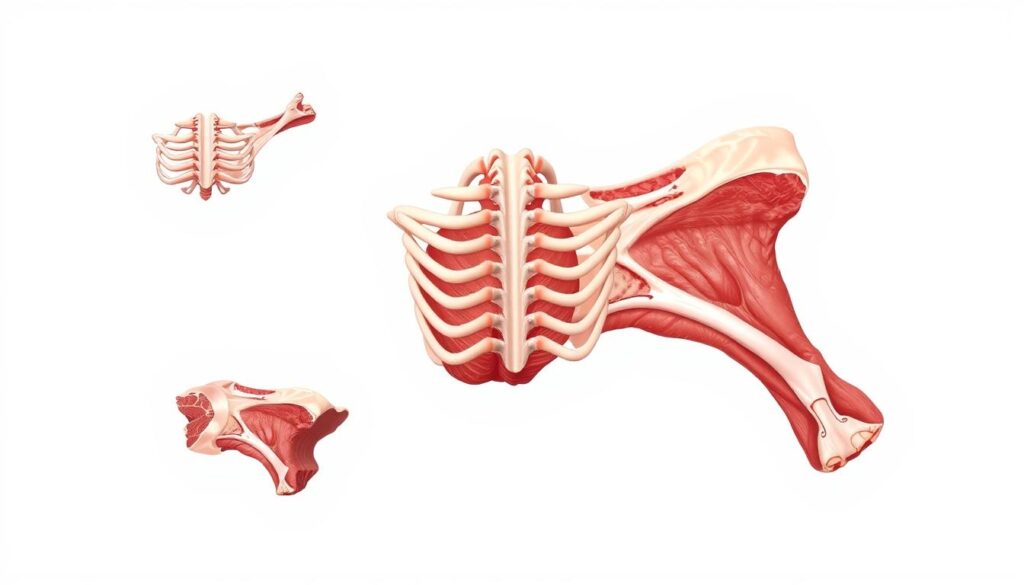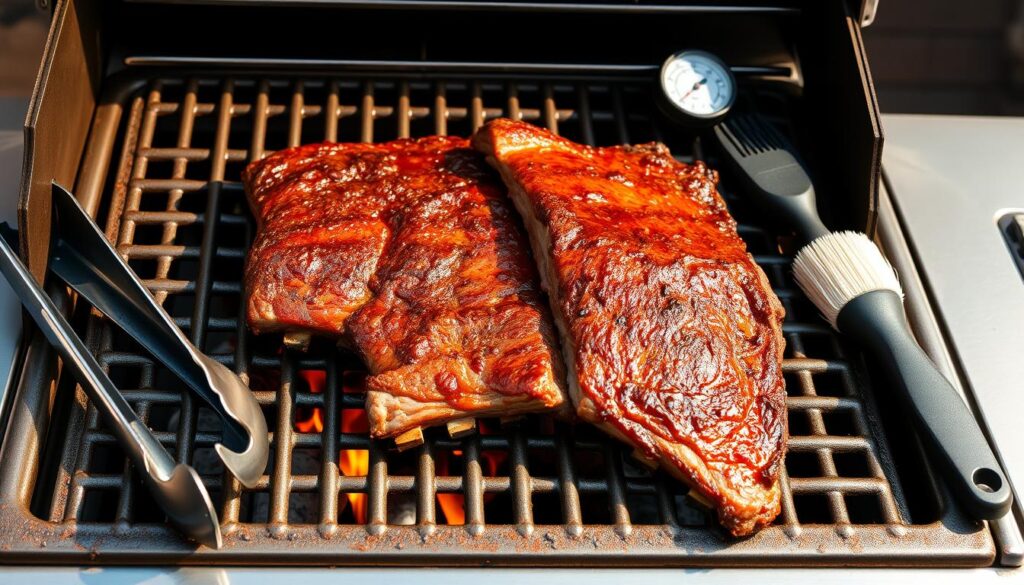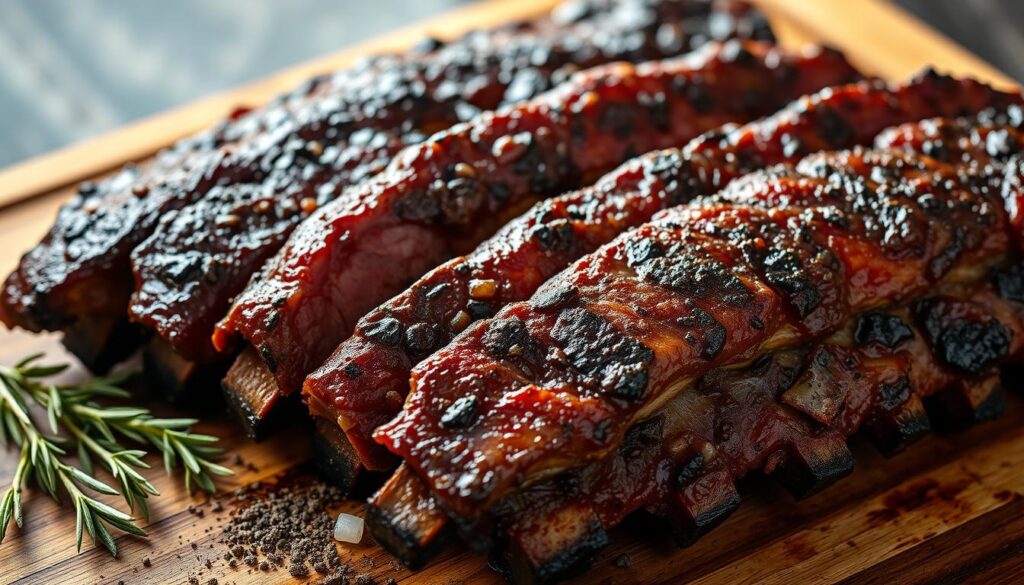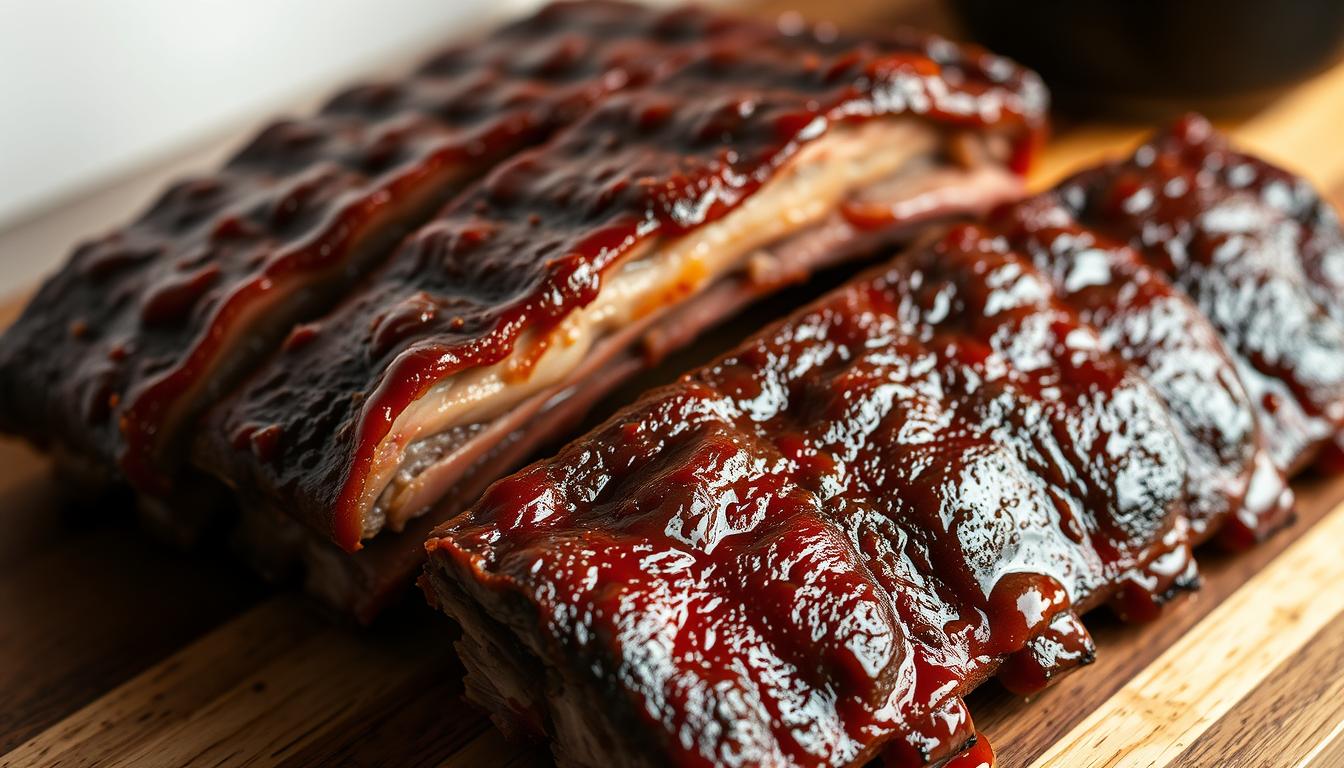Every great cook has a signature dish that makes meals unforgettable. For me, mastering the perfect beef back ribs recipe was a journey. It was filled with passion, patience, and excitement. The first time I got those tender, smoky ribs right, I knew I’d found something special.
Barbecue ribs are more than just a meal; they’re an art form. They connect us to generations of cooking traditions. Whether it’s for a backyard cookout or a weekend dinner, this recipe will make your cooking shine. It will impress everyone at the table.
In this guide, we’ll simplify the process into four easy steps. You’ll learn how to pick the best cuts, make delicious seasonings, and use cooking techniques for perfect results. Every time you cook, you’ll get succulent ribs.
Key Takeaways
- Master the ultimate beef back ribs recipe in just 4 easy steps
- Learn professional techniques for selecting and preparing ribs
- Discover the secrets to tender, flavor-packed barbecue ribs
- Transform your home cooking with restaurant-quality results
- Understand the essential techniques for perfect rib preparation
Table of Contents
Understanding Beef Back Ribs: Anatomy and Selection
When cooking smoked beef ribs or oven-baked ribs, knowing your meat is key. Beef back ribs are special and tasty, but they need the right cooking to shine.

What Sets Back Ribs Apart
Beef back ribs come from the cow’s prime rib area. They offer a unique taste experience. Here’s what makes them different:
- Located in the upper rib cage section
- Less meat on top of the bones compared to short ribs
- Tender meat nestled between bone sections
- Rich, robust flavor profile
Selecting Quality Beef Back Ribs
When you’re shopping for smoked beef ribs, keep these tips in mind:
- Look for consistent marbling throughout the meat
- Choose ribs with a fresh, deep red color
- Avoid cuts with excessive surface fat
- Check for uniform thickness across the rack
The Silverskin Challenge
The silverskin membrane can make your ribs chewy if not removed. It’s a thin, silvery layer that stops seasonings from getting in. Taking it off before cooking makes your ribs more tender and flavorful.
Pro tip: Use a sharp knife to carefully peel back the membrane from one end of the rack, gripping it with a paper towel for better control.
Essential Equipment and Ingredients for Perfect Ribs
Grilling ribs is more than just skill. You need the right tools and ingredients to make them delicious. A well-stocked kitchen and the right tools are key to tender, flavorful ribs.

- Smoker or oven
- Digital meat thermometer
- Heavy-duty aluminum foil
- Cutting board
- Sharp boning knife
For your rib rub seasoning, get these ingredients:
| Dry Rub Ingredients | Quantity |
|---|---|
| Brown sugar | 1/4 cup |
| Kosher salt | 2 tablespoons |
| Black pepper | 1 tablespoon |
| Paprika | 1 tablespoon |
| Garlic powder | 1 teaspoon |
Quality equipment makes your ribs perfect every time. A good thermometer checks meat temperatures. Good foil keeps ribs safe during cooking. Your rib rub seasoning adds amazing flavor.
Pro tip: Always choose fresh, high-quality ingredients for the best results in your rib-cooking journey.
The Ultimate Beef Back Ribs Recipe
Turning tough beef back ribs into tender ribs needs skill and patience. This guide will help you make delicious dry rub ribs. It covers every important step.

Preparing the Meat
Begin by rinsing your beef back ribs under cold water. Dry them with paper towels to help the dry rub stick. Check for any extra fat or unwanted membrane.
- Rinse ribs carefully
- Pat completely dry
- Remove excess fat
Creating the Perfect Dry Rub
Making a great dry rub is key for tender ribs. Your spice mix will set the flavor and taste.
| Ingredient | Quantity | Purpose |
|---|---|---|
| Brown Sugar | 1/4 cup | Caramelization |
| Paprika | 2 tbsp | Color and mild heat |
| Black Pepper | 1 tbsp | Spicy kick |
| Kosher Salt | 2 tbsp | Enhanced flavor |
Cooking Temperature and Time Guidelines
Getting the cooking right is crucial for tender ribs. Keep the temperature low and cook for a long time.
- Preheat smoker or oven to 225-275°F
- Cook for 3-8 hours
- Check internal temperature reaches 203°F
Pro tip: Use a meat thermometer to ensure perfect doneness without guesswork.
Mastering the Dry Rub Seasoning
Making the perfect rib rub seasoning is an art. It can turn your beef back ribs into something amazing. A great dry rub recipe mixes different flavors that enhance the meat’s taste.
Your dry rub should have a few key parts:
- Sweet base (brown sugar)
- Salt for enhancement
- Spicy kick (chili powder)
- Aromatic spices
The secret to a great rib rub seasoning is knowing about flavor chemistry. Begin with a basic mix of:
- 2 tablespoons brown sugar
- 1 tablespoon paprika
- 1 teaspoon garlic powder
- 1 teaspoon black pepper
- 1/2 teaspoon cayenne
Pro tip: Always massage your dry rub ribs well to get the flavors deep inside. The spices should make a nice crust. This crust keeps the meat moist and adds to the flavor.
“A perfectly crafted dry rub turns good ribs into a culinary masterpiece” – BBQ Experts
Try different things with your rib rub seasoning to make it your own. Feel free to change the amounts and add spices like smoked paprika or ground coffee. These can add interesting flavors.
Preparation Techniques for Tender Results
Creating fall-off-the-bone ribs starts with careful preparation. The right techniques can turn ordinary beef back ribs into a delicious treat. It will impress your guests and satisfy your taste buds.
Preparing tender beef ribs needs attention to detail and a few key steps. Professional chefs say that proper preparation is the secret to those irresistible, succulent ribs everyone loves.
Removing the Membrane
The membrane, or silverskin, can stop your ribs from becoming tender. Here’s how to remove it effectively:
- Locate the tough membrane on the bone side of the ribs
- Use a butter knife to loosen a corner of the membrane
- Grip the loosened edge with a paper towel for better grip
- Pull the membrane off in one smooth motion
Precision Trimming Techniques
Trimming your beef back ribs correctly ensures maximum flavor and tenderness:
- Remove excessive fat patches
- Leave a thin layer of fat for moisture
- Trim any uneven edges for consistent cooking
- Cut away any hard or discolored sections
By following these preparation techniques, you’ll be well on your way to creating fall-off-the-bone ribs. They will have everyone asking for your secret recipe.
Smoking vs. Oven-Baking Methods
When making smoked beef ribs, you’ll find two main ways to cook them. Each method has its own benefits that can make your BBQ better.
Smoking beef ribs needs patience and care. You cook the meat slowly at low heat, usually between 225-275°F. Choosing the right wood is key for great flavors. Popular woods include:
- Hickory for bold, bacon-like taste
- Oak for consistent, medium-intense smoke
- Mesquite for strong, earthy notes
Oven-baked ribs are a good choice if you don’t have a smoker. They can get just as tender as smoked ribs by keeping the oven at 300°F. The trick is to keep the meat moist so it doesn’t dry out.
The cooking method affects the flavor and texture of the ribs. Smoked ribs get a richer taste from the wood smoke. Oven-baked ribs can also be delicious with the right seasonings and oven temperature.
“The secret is understanding your equipment and respecting the meat’s natural characteristics.”
Smoking takes 3-8 hours, while oven-baked ribs are ready in 2-3 hours. No matter the method, cooking low and slow is key for tender ribs.
Temperature Control and Cooking Times
To get fall-off-the-bone ribs, you need to control the temperature well. Cooking tender beef ribs is an art that requires focus and knowledge of heat. You must watch the internal temperatures closely and know when to stop.
Mastering rib temperature involves several key stages. These stages turn tough meat into tender, delicious ribs. The path to perfectly cooked ribs needs patience and smart heat use.
Critical Temperature Milestones
When cooking fall-off-the-bone ribs, tracking internal temperature is crucial. Here are the main temperature stages to watch:
- Initial cooking phase: Start at 225°F-250°F ambient temperature
- Internal meat temperature: Target 203°F (95°C) for maximum tenderness
- Cooking duration: Typically 4-6 hours depending on rib size
Determining Rib Doneness
Knowing when your tender beef ribs are done is more than just about temperature. Look for these signs:
- Meat pulls back from bone ends
- Bones wiggle easily when gently twisted
- Surface develops a rich, mahogany-colored bark
Professional pitmasters suggest using a reliable leave-in probe thermometer. This tool helps you monitor accurately. It ensures your ribs are tender every time.
Creating the Perfect BBQ Sauce
Making the perfect barbecue ribs sauce can take your meat from good to amazing. A great rib marinade turns your cooking into something special. It adds depth and excitement to every bite.
Begin with a classic mix of sweet, tangy, and spicy. Your homemade BBQ sauce should enhance the flavor of beef back ribs without overpowering them.
- Ketchup: Provides a tomato-rich foundation
- Brown sugar: Adds deep sweetness
- Apple cider vinegar: Introduces a sharp tang
- Worcestershire sauce: Brings umami complexity
- Spices: Paprika, garlic powder, black pepper
When making your rib marinade, remember to keep things balanced. You want a sauce that sticks to the meat and caramelizes well during cooking.
| Ingredient | Quantity | Purpose |
|---|---|---|
| Ketchup | 1 cup | Base and texture |
| Brown Sugar | 1/4 cup | Sweetness and caramelization |
| Apple Cider Vinegar | 2 tbsp | Tanginess and balance |
Pro tip: Simmer your sauce for about an hour to develop rich, complex flavors. This slow cooking process allows ingredients to meld. It creates a truly memorable barbecue ribs experience.
Resting and Serving Techniques
Getting your ribs to fall-off-the-bone perfection isn’t just about cooking. The resting phase is key. It turns good ribs into tender, impressive dishes that wow your guests.
Once your ribs are out of the heat, patience is your best friend. Let them rest for 15-20 minutes. This lets the juices spread evenly, making each bite moist and full of flavor.
Resting Techniques for Maximum Tenderness
- Wrap ribs in aluminum foil to retain heat and moisture
- Place ribs in an insulated cooler for up to an hour
- Keep ribs in a warm oven set at 170°F
The “faux Cambro” method is a game-changer. It wraps ribs in foil and puts them in a cooler. This keeps the meat tenderizing without losing heat, making the ribs incredibly tender.
Cutting and Serving Tips
When you serve, use a sharp knife to cut between the bones. Aim for portions with 2-3 bones each. Make it look good by arranging the ribs on a platter with fresh herbs.
Pro tip: Always cut against the grain to maximize tenderness and ensure each bite is as delicious as possible.
Pair your tender beef ribs with classic sides like coleslaw, cornbread, or grilled veggies. This creates a complete, satisfying meal that will have everyone asking for more.
Troubleshooting Common Issues
Cooking tender beef ribs can be tough, even for pros. But, most problems have easy fixes.
Barbecue ribs face many common issues. Knowing how to solve these can make your meat perfect every time.
Handling Tough Meat Challenges
If your beef back ribs are tough, they just need more time. Here’s how to fix them:
- Keep cooking at low temperature (225-250°F)
- Wrap ribs in foil to keep moisture in
- Try liquid injection for extra tenderness
- Make sure the internal temperature hits 195-203°F
Managing Cooking Temperature Problems
Keeping the temperature right is key for tender ribs. For temperature issues, try these:
- Use a good digital meat thermometer
- Adjust smoker or oven vents with care
- Keep the heat steady during cooking
- Let the ribs rest properly after cooking
Remember, patience is crucial when making barbecue ribs. Slow cooking leads to the best taste.
Conclusion
Your journey to make the best beef back ribs recipe is a fun adventure. You’ll learn about choosing the right meat, seasoning, and cooking techniques. This will turn simple barbecue ribs into a special meal.
Getting better at making beef back ribs takes practice. Every time you cook, you’ll learn more about controlling temperature, using dry rubs, and preparing the meat. Feel free to try new smoking methods or change your seasonings to match your taste.
With what you’ve learned, your home cooking will become as good as a pro’s. Be patient and pay close attention to every detail. Soon, you’ll be serving ribs that everyone will love. You’ll be the hero of any outdoor party or BBQ.
Remember, making great barbecue ribs is about passion, creativity, and enjoying the journey. Keep trying new things, learning more, and always keep grilling!

